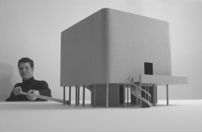2002 – 2005. The installation of this work consists of a 71 x 145 cm transparency mounted in a light box (81 x 155 x 15 cm) and a 2:00 minute video projection, looped. The subjects of the photograph and video are five 1:50 scale reproductions of Modernist pavilions made of archival corrugated cardboard and placed on a 240 x 240 cm platform. Still Photography: Ray Anastas. Digital Imaging and printing: Stephen Gross. Video Camera: Rubén Guzmán. Edit: Anita Chao and Greg Allen. Exhibited at Galerie für Zeitgenössische Kunst, Leipzig (Was wäre, wenn…, curated by Julia Schäfer, July – September, 2005); Laboratorio Arte Alameda, Mexico City (Terence Gower: Ciudad Moderna, July – October, 2005); Queens Museum of Art, New York (The Gift, curated by Valerie Smith and Hitomi Iwasaki, November 2005 – February 2006).

Preparing for the video shoot. Photograph: Ray Anastas
One of the most recognized forms of architectural representation is the scale model. The scale model communicates the architect’s ideas to the client in three dimensions before the real building begins. It is a model for the finished structure, but it often hangs around after construction to be used in exhibitions or in the office to display the architect’s work to prospective clients.
My work with scale reproductions is a meditation on this relationship between model and representation. The scale reproductions I build are miniature copies of real buildings. I have thus inverted the traditional relationship between original and copy, between building and model. The full-scale, finished building is the model for what I am building. Because I am interested in reproducing exhibition pavilions, the originals are often no longer standing, since they were designed as temporary structures. I work from photographs and published plans, which means I rely on copies of the original. In this process, I turn the building I am copying into a model of itself. It represents itself the same way a commodity in a display represents itself. My act of copying turns the original building into display architecture.
5 Notable Pavilions is a free experiment in which I continue this chain of copying and reproduction through a series of media, testing the effects of scale and movement along the way. I am interested in the Modernist pavilion for formal and historical reasons. My process of building scale reproductions enacts the relationship of model to copy, but it is also a process of intuitive analysis or “physical meditation” on form. I familiarize myself with the form of each pavilion through the meticulous observation of the original, then the translation of that into three dimensions. The original re-embodies its original three-dimensional form (in miniature) in my hands. The pavilions in this piece have been modified so they can share the same flat site (eg. Alvar Aalto designed the Finnish Pavilion for a sloping site at the Trocadero. I’ve adapted it to a flat site by continuing Aalto’s pilotis all around the structure.) The material, corrugated cardboard, offered challenges and opportunities. For instance, corrugation was used for the brise-soleil in the reproduction of Oscar Niemeyer’s Brazil Pavilion.
I hired photographer Ray Anastas to photograph the group of models (some of his images are reproduced on the previous pages.) I then mounted one image as a backlit transparency, a traditional commercial exhibition display format. This “establishing shot” is what is shown in museum presentations of this work, adjacent to a video “tour” of the group (filmed by Rubén Guzmán).
Watching the video, the viewer is suddenly confronted with a new understanding of the spatial relationships in the group. When the video is projected large, the viewer discovers himself or herself on an architectural promenade through this imaginary complex at 1:2 scale. One gets a strong sense of traveling as the camera passes a row of columns that quickly come together, disappear behind the foremost, then expand out again from the other side. The ghostly gray of the pavilions gives off the impression of images preserved in memories.